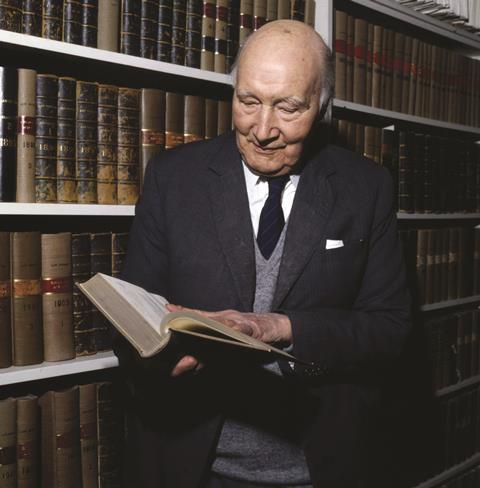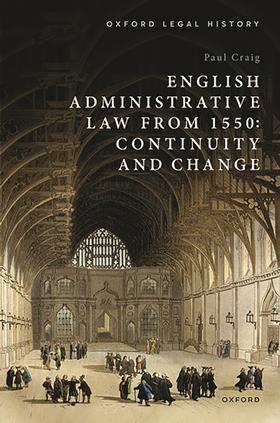English Administrative Law from 1550: Continuity and Change
Paul Craig
£140, Oxford University Press
★★★★★
Lawyers in England and Wales can sometimes seem a little strange. All that effort to get into a reputable university, to achieve the best grades, to get into the best firm is for some not a prelude to deeper reflection, but just a necessary sacrifice for a career. Reading law reports soon becomes a task to be delegated to juniors. And as for ever wondering why the law might be as it is, what its history might be, that is unprofitable speculation and may be ignored. If they think about legal history at all, most are quite happy for the most superficial understanding of our own subject to suffice.
There is also a tendency to think of administrative law as a relatively modern concept with no deep roots in the common law. Albert Venn Dicey famously said that administrative law was unknown to English jurisprudence. Lord Denning (pictured) took much credit for reinventing it in the 1960s.

However, as Paul Craig shows in his masterful sweep of nearly 500 years of case law, we have had a sophisticated and nuanced approach to administrative law from at least the Elizabethan period. Professor Craig shows how throughout English legal history judges, lawyers and litigants have grappled with the way in which the law can control executive powers.
Take, for example, James Bagg’s Case (1615) 11 Co Rep 93b. As Craig explains, Bagg appears to have had a problem with authority. He was a burgess of Plymouth but fell out with mayor Thomas Fowens and other burgesses. Bagg expressed himself in forthright terms, as set out in the pleadings, ‘in contempt and disdain of the aforesaid Thomas Fowens… turning the hinder part of his body in an inhuman and uncivil manner towards the aforesaid… scoffingly, contemptuously and uncivilly with a loud voice, said to the aforesaid Thomas Fowens these words following, that is to say “come and kiss”’ and then a moment later ‘I will make thy neck crack’. Bagg was, perhaps not surprisingly, disenfranchised by the mayor and burgesses of Plymouth, but surprisingly Chief Justice Sir Edward Coke found for him. His disenfranchisement merited a hearing. Bagg had not been ‘reasonably warned’ of the consequence of his behaviour and the disenfranchisement could not stand. The decision of the corporation – an administrative act, not a judicial one – was thus overturned nearly 350 years before Ridge v Baldwin [1964] AC 40. Ridge was a case many might have thought marked the start of natural justice having a role in administrative law.

Reviewing nearly 500 years of precedent is a daunting and extraordinary achievement. Ironically, one factor that has enabled Craig to take his journey into legal history has been the digitisation of the English Reports. Where digitisation has been revelatory is in anchoring a concept of proportionality not as a foreign import to our administrative law (from the German concept of Verhältnismäßigkeit, via the ECJ and now entrenched in principles set out in the Equality Act 2010), but as a homegrown concept. Its English origins can be traced back at least as far as Rooke’s Case (1598) 5 Co Rep 99b, on how the Statute of Sewers 1531 23 Henry 8 c 5 should be interpreted. While the term the courts employed was proportionability rather than proportionality, the concept performed a leading role in shaping the criteria deemed relevant for the resolution of any particular case. Examples include the decisions of judges such as Coke, Ellenborough, Blackstone and Mansfield.
After an introductory essay setting out the work’s intentions, the book is divided into three further substantive parts – Regulation and Administration, Courts and Doctrine, and Remedies and Review. While this means that there can be an element of repetition, that aids understanding of how elements of the topic interrelate. Craig demolishes the notion that a concept of administrative law was lacking in our jurisprudence until the 20th century. That may seem an interesting academic footnote to discussions on Ridge v Baldwin or the old Ord 53 RSC (the predecessor to Part 54 of the CPR which, among other things, modernised the old prerogative writs). But the importance of Craig’s work goes far beyond mere legal antiquarianism. The reluctance to accept that administrative action and its control through the courts have been part of our jurisprudence for hundreds of years has skewed the development and understanding of the subject, not just from narrow legal perspectives but even more importantly from a sociological and political perspective too.
It should not be necessary to point out how important this is. Administrative law is about the correct ways power can be delegated and applied. Craig has done us all a service in emphasising that English administrative law is not some recent modern evil, but necessary and created to combat what Lord Hewart famously referred to as The New Despotism.
Craig concludes his epic work by saying that he never learned so much from writing a book. I am sure that the reader who has joined Craig in his quest to review 500 years of English legal history will echo that sentiment. Far from being an alien concept in the way that Dicey and Hewart LCJ understood it, administrative law has been a feature of our national story from the late Middle Ages onwards.
It would be wonderful if this work reached out beyond the narrow confines of the specialist legal historian, to prompt sociologists and political scientists to re-evaluate how the state distributes and controls its primary resource – power.
Max D Winthrop is a partner at Sintons LLP in Newcastle































No comments yet